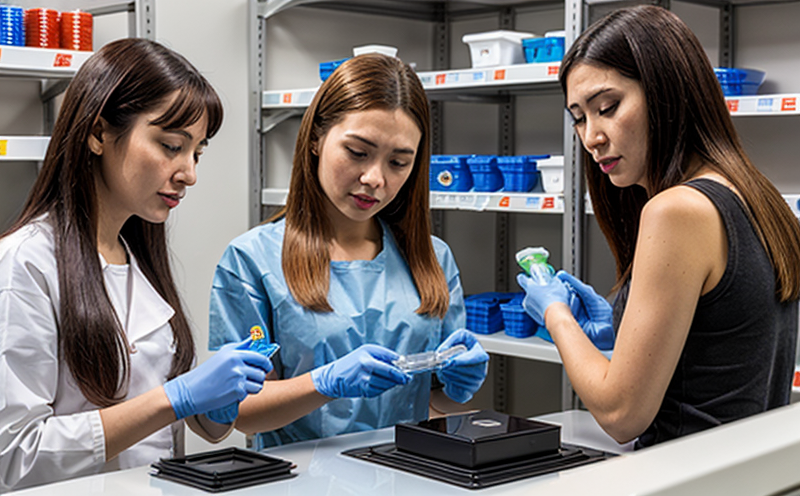EN 12221 Safety Testing of Plastic Baby Changing Units
The European Standard EN 12221:2005 specifies safety requirements and testing procedures for plastic baby changing units. These units are essential components in nurseries, day-care facilities, and public spaces where children require diaper changes. The standard ensures that the products meet stringent safety criteria to protect infants from potential hazards such as sharp edges, small parts, and toxic materials.
The compliance with EN 12221 is critical for manufacturers aiming to export their products across Europe or sell in regulated markets. This service provides comprehensive testing according to this standard, ensuring that the baby changing units are safe for use by infants. Our laboratory adheres strictly to international standards such as ISO and ASTM, which further enhances confidence in our test results.
The testing covers various aspects of the product, including:
- Structural integrity
- Material safety
- Sharp edges and points
- Small parts that could pose a choking hazard
- Flammability resistance
- Chemical compliance (e.g., PVC, phthalates)
The testing process involves detailed evaluation of the physical structure as well as chemical analysis. Our experts ensure thorough examination to guarantee that no aspect is overlooked in meeting safety standards.
| Test Parameter | Description | Methodology |
|---|---|---|
| Structural Intactness Test | Evaluates the durability and strength of the unit under simulated stress. | The unit is subjected to a series of loading tests to determine its ability to withstand typical use without compromising safety. |
| Small Parts Test | Checks for any detachable components that could be small enough to pose a choking hazard. | The unit is disassembled, and all parts are measured against the specified size limits. |
| Flammability Test | Evaluates how quickly the material ignites and burns under controlled conditions. | A standard flame test is conducted to ensure that the material does not ignite easily or burn excessively fast. |
The results of these tests are meticulously documented, providing detailed reports that outline any potential hazards identified. Compliance with EN 12221 ensures that the baby changing units meet all necessary safety standards, offering peace of mind to manufacturers and consumers alike.
Scope and Methodology
The scope of testing under EN 12221 includes an evaluation of various aspects critical for ensuring the safety of plastic baby changing units. This section outlines the specific tests conducted and the methodologies employed to achieve compliance with this standard.
| Test Parameter | Description | Methodology |
|---|---|---|
| Structural Intactness Test | Evaluates the durability and strength of the unit under simulated stress. | The unit is subjected to a series of loading tests to determine its ability to withstand typical use without compromising safety. |
| Small Parts Test | Checks for any detachable components that could be small enough to pose a choking hazard. | The unit is disassembled, and all parts are measured against the specified size limits. |
| Flammability Test | Evaluates how quickly the material ignites and burns under controlled conditions. | A standard flame test is conducted to ensure that the material does not ignite easily or burn excessively fast. |
The methodology for each test is designed to simulate real-world usage while adhering strictly to the requirements of EN 12221. This ensures that any potential hazards are identified and addressed, providing a comprehensive safety evaluation.
Benefits
Compliance with EN 12221 offers numerous benefits to manufacturers and consumers alike:
- Market Access: Ensures products are safe for sale in the European Union and other markets requiring this standard.
- Consumer Confidence: Provides assurance that the product is free from hazards, enhancing trust among parents and caregivers.
- Regulatory Compliance: Helps avoid potential legal issues and penalties associated with non-compliance.
- Risk Mitigation: Identifies and mitigates potential risks early in the development process.
The testing service offered by our laboratory not only ensures safety but also supports product innovation. By adhering to this standard, manufacturers can focus on improving their products while ensuring they meet all necessary regulatory requirements.
International Acceptance and Recognition
EN 12221 is widely recognized across the European Union and beyond for its stringent safety criteria. Here are some key points regarding its international acceptance:
- European Market: Essential for manufacturers wishing to sell products in EU countries.
- Global Compliance: The standard is often used as a benchmark for other regional standards, ensuring universal safety.
- Regulatory Bodies: Accepted by various regulatory bodies including the European Commission and national authorities.
The widespread acceptance of EN 12221 underscores its importance in the global market. Compliance is not only a requirement but also a testament to the quality and safety of products.





